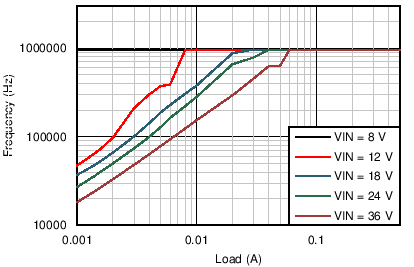ZHCSCW5B August 2014 – September 2017 LM43600
PRODUCTION DATA.
- 1 特性
- 2 应用
- 3 说明
- 4 简化电路原理图
- 5 修订历史记录
- 6 Pin Configuration and Functions
- 7 Specifications
-
8 Detailed Description
- 8.1 Overview
- 8.2 Functional Block Diagram
- 8.3
Feature Description
- 8.3.1 Fixed Frequency Peak Current Mode Controlled Step-Down Regulator
- 8.3.2 Light Load Operation
- 8.3.3 Adjustable Output Voltage
- 8.3.4 Enable (ENABLE)
- 8.3.5 VCC, UVLO and BIAS
- 8.3.6 Soft Start and Voltage Tracking (SS/TRK)
- 8.3.7 Switching Frequency (RT) and Synchronization (SYNC)
- 8.3.8 Minimum ON-Time, Minimum OFF-Time and Frequency Foldback at Dropout Conditions
- 8.3.9 Internal Compensation and CFF
- 8.3.10 Bootstrap Voltage (BOOT)
- 8.3.11 Power Good (PGOOD)
- 8.3.12 Overcurrent and Short-Circuit Protection
- 8.3.13 Thermal Shutdown
- 8.4 Device Functional Modes
-
9 Applications and Implementation
- 9.1 Application Information
- 9.2
Typical Applications
- 9.2.1 Design Requirements
- 9.2.2
Detailed Design Procedure
- 9.2.2.1 Custom Design With WEBENCH® Tools
- 9.2.2.2 Output Voltage Setpoint
- 9.2.2.3 Switching Frequency
- 9.2.2.4 Input Capacitors
- 9.2.2.5 Inductor Selection
- 9.2.2.6 Output Capacitor Selection
- 9.2.2.7 Feedforward Capacitor
- 9.2.2.8 Bootstrap Capacitors
- 9.2.2.9 VCC Capacitor
- 9.2.2.10 BIAS Capacitors
- 9.2.2.11 Soft-Start Capacitors
- 9.2.2.12 Undervoltage Lockout Setpoint
- 9.2.2.13 PGOOD
- 9.2.3 Application Performance Curves
- 10Power Supply Recommendations
- 11Layout
- 12器件和文档支持
- 13机械、封装和可订购信息
封装选项
请参考 PDF 数据表获取器件具体的封装图。
机械数据 (封装 | 引脚)
- PWP|16
散热焊盘机械数据 (封装 | 引脚)
- PWP|16
订购信息
8.3.2 Light Load Operation
DCM operation is employed in the LM43600 when the inductor current valley reaches zero. The LM43600 will be in DCM when load current is less than half of the peak-to-peak inductor current ripple in CCM. In DCM, the LS switch is turned off when the inductor current reaches zero. Switching loss is reduced by turning off the LS FET at zero current and the conduction loss is lowered by not allowing negative current conduction. Power conversion efficiency is higher in DCM than CCM under the same conditions.
In DCM, the HS switch ON time will reduce with lower load current. When either the minimum HS switch ON time (TON-MIN) or the minimum peak inductor current (IPEAK-MIN) is reached, the switching frequency will decrease to maintain regulation. At this point, the LM43600 operates in PFM. In PFM, switching frequency is decreased by the control loop when load current reduces to maintain output voltage regulation. Switching loss is further reduced in PFM operation due to less frequent switching actions. Figure 34 shows an example of switching frequency decreases with decreased load current.
 Figure 34. Switching Frequency Decreases with Lower Load Current in PFM Operation
Figure 34. Switching Frequency Decreases with Lower Load Current in PFM Operation
VOUT = 5 V FS = 1 MHz
In PFM operation, a small positive DC offset is required at the output voltage to activate the PFM detector. The lower the frequency in PFM, the more DC offset is needed at VOUT. Please refer to the Typical Characteristics for typical DC offset at very light load. If the DC offset on VOUT is not acceptable for a given application, a static load at output is recommended to reduce or eliminate the offset. Lowering values of the feedback divider RFBT and RFBB can also serve as a static load. In conditions with low VIN and/or high frequency, the LM43600 may not enter PFM mode if the output voltage cannot be charged up to provide the trigger to activate the PFM detector. Once the LM43600 is operating in PFM mode at higher VIN, it will remain in PFM operation when VIN is reduced.